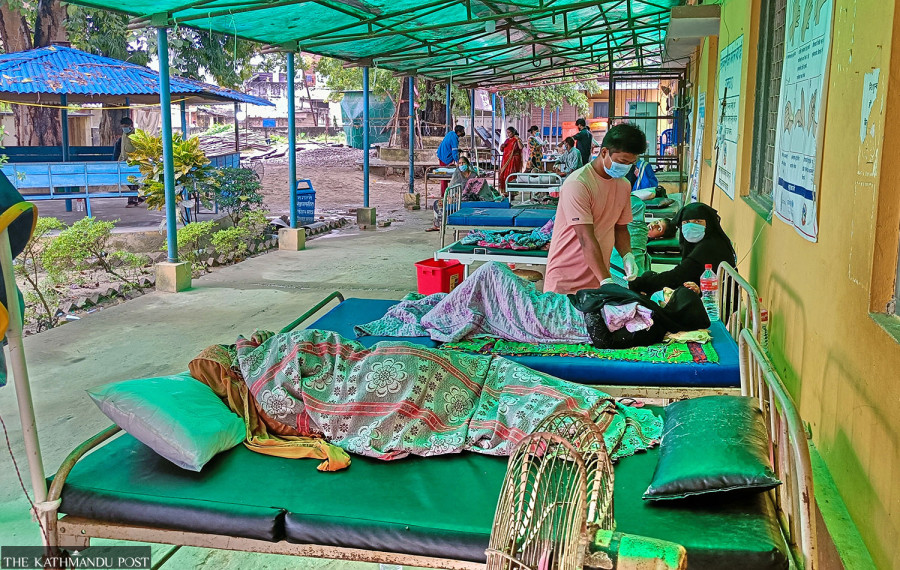Health
It took two weeks just to diagnose Kapilvastu cholera outbreak
The outbreak in wards 7, 8 and 9 of Krishnanagar Municipality in Kapilvastu, which has claimed four lives and sickened 900 people, has yet to come under control.
Arjun Poudel
In 2009, when a diarrheal outbreak started in Jajarkot, then secretary of the Ministry of Health and Population summoned the director of the Epidemiology and Disease Control Division and inquired about the possible causes.
The director told the secretary that cholera might be responsible, considering the symptoms that patients showed and the accounts of health workers deployed in the disease-hit areas.
“When the number of deaths started rising, doctors and health workers were deployed to the affected areas. They treated the patients and also brought stool and water samples to Kathmandu for tests,” Dr Baburam Marasini, a former director at the Epidemiology and Disease Control Division, told the Post.
Now, after eleven years, several wards of Krishnanagar Municipality in Kapilvastu have been hit by a similar outbreak since the first week of October. It has so far claimed four lives and affected over 900. The deceased include three minors—seven- and two-year-old boys and a five-year-old girl. Another deceased was a 45-year-old man.
Although the government dispatched health workers to the area and stool and water samples were brought for tests in Kathmandu twelve days ago, it took over a week for the authorities to identify the cause of the outbreak.
“Nothing seems to have changed in the last eleven years,” Marasini said. “Do you call it progress when it still takes two weeks to identify the cause of the outbreak and we still have to bring the samples to Kathmandu as there are no good labs in the districts?” he questioned.
In 2009, the District Public Health office, Jajarkot had confirmed 96 diarrheal deaths in the district.
After 2009, several major diarrheal outbreaks have occurred in various districts including in Rautahat and scores have succumbed. However, the response and approach of the authorities in tackling such waterborne diseases has not changed much.
“It is very unfortunate to see that Nepalis are still dying from diarrheal diseases in the 21st century,” said Dr Sher Bahadur Pun, chief of the Clinical Research Unit at the Sukraraj Tropical and Infectious Hospital. “We don’t know how long we will have to continue getting infected and dying this way as safe drinking water is still a far cry in our country.”
Doctors say diarrheal diseases including cholera are caused by contaminated water, which can be contained by increasing access to safe drinking water.
The diarrheal outbreak in wards 7, 8 and 9 of Krishnanagar Municipality in Kapilvastu has yet to come under control.
The Ministry of Health and Population has confirmed the presence of Vibrio cholerae 01 Ogawa serotype in stool samples of the patients in the disease-hit region.
E. Coli has been detected in drinking water samples of the disease-hit areas.
“Over a dozen people are still getting infected daily from the diarrheal disease,” Dr Bikash Devkota, secretary for provincial Ministry of Health and Population of Lumbini Province, told the Post. “We have been working to contain further spread of the disease.”
Cholera is a highly infectious disease that causes severe diarrhoea and vomiting, which leads to dehydration and can even kill the patient within a few hours if left untreated. Escherichia coli, or E. coli, is a bacteria that normally lives in the intestines of people and animals. Most types of E. coli are harmless and even help keep the digestive tract healthy. But some strains cause diarrhoea when one eats or drinks contaminated food and water.
Devkota said contaminated drinking water is responsible for the cholera outbreak in Krishnanagar Municipality.
Cholera continues to be a major killer in many poor countries which lack safe drinking water and proper sanitation infrastructure.
Nepal is also a cholera endemic country as cases of infection by the deadly disease are detected every year across the country including in the Capital itself.
Doctors say poor sanitation and contaminated drinking water are the main causes of a cholera outbreak.
Asked how long Nepali people will have to continue dying from diarrheal diseases and what the authorities have been doing to prevent waterborne diseases, Devkota said the health agencies alone cannot prevent diarrheal outbreaks as the response involves a concerted effort from various sectors.
Several agencies of the government including those under the Health Ministry, the Ministry of Water Supply and Sanitation, the Ministry of Education, Science and Technology, and non-governmental agencies should make coordinated efforts to contain the waterborne disease, according to Devkota.
“However, instead of taking the issue seriously and making prompt decisions, our officials direct their subordinates not to disclose facts and try to conceal the problem,” said Marasini, former director at the Epidemiology and Disease Control Division.
“Delay in testing the samples clearly indicates that the authorities have not taken the issue seriously and it is not the case only with diarrheal outbreaks but also other ailments such as Covid-19.”
Meanwhile, officials at the Health Ministry claimed that the situation is under control in Kapilvastu and they have taken every measure to contain the outbreak.
“It took time to collect samples and bring them to Kathmandu for further confirmation,” said Dr Krishna Prasad Paudel, spokesperson for the Health Ministry. “Cholera was detected only in a few samples. Just because it took a long time to establish the cause of the outbreak does not mean nothing had been done in the affected areas.”
He also blamed contaminated drinking water for the outbreak.




 9.12°C Kathmandu
9.12°C Kathmandu














